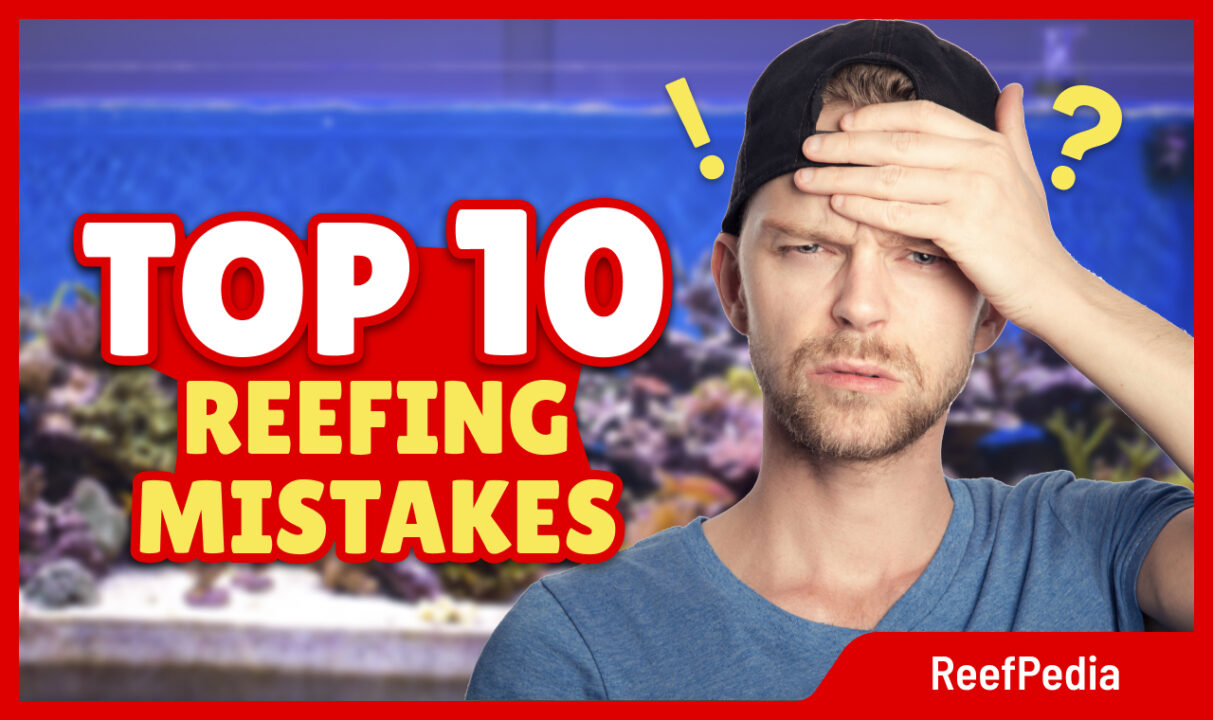Table of Contents
Marine aquaristics is considered to be a rather demanding hobby. But don’t be fooled, as nowadays wide access to knowledge and modern technical solutions make this opinion a thing of the past. However, before setting up our first aquarium, it is worth taking some time to prepare well and avoid some common mistakes that aquarists make, putting their beautiful tanks at risk.
1. Mistakes when choosing the size of the aquarium
Nothing prevents you from building any size of tank, but it is worth knowing what this may entail.
Will a small aquarium be easy to maintain?
A 60 x 60 cm cube takes up a small area and can look very impressive. Equally important, it must be taken into consideration that this is a very small water volume, so natural chemical processes occur more rapidly than in larger tanks. Nitrogen or phosphorus metabolism can cause strong fluctuations in key parameters and stress the inhabitants of the tank as a result.
Is a large aquarium easy to maintain?
Certainly the chemical processes run more smoothly, there is more time to bring the aquarium parameters to a stable state. With very large and deep aquariums, too little suitable light, i.e. coral food, too little water circulation and organic waste build-up can be a problem. A large aquarium will require more water to be changed and time to be spent bringing it to a satisfactory condition.
In either case, however, the result can be delightful, so it is worth choosing the size of tank that will bring you the most satisfaction.
For more advice on choosing an aquarium size, see Aquarium set up – what size should I choose?
2. Equipment buying mistakes
Marine aquaristics differs significantly from freshwater aquaristics. The equipment we use in aquariums and sumps not only comes into contact with water, but also with salt.
A common mistake is to buy equipment cheaply. There is a high risk that they will quickly fail in this demanding environment. A low price is often associated with lower quality, poorer fitting of components and weakened seals. Worse still, in order to save money, we sometimes buy the same or a similar model again. As a result, we pay a much higher price overall and unnecessarily risk the lives of our animals! A better solution seems to be to invest straight away in a device that is more expensive but has positive reviews in the aquaristic community.
It is also important to remember that a saltwater aquarium has its own phases of maturation and development, so it is not necessary to invest in every recommended piece of equipment right away. So don’t buy everything at the beginning, as some things may not be useful to you for a long time.
When buying equipment, it is worth mentioning second-hand equipment. We often come across offers to buy an aquarium or its individual components, and here, as always when buying used things, you should be careful. Appliances with clear traces of salt or rust, which have not been in use for a long period of time, can pose a great risk. Rust is very dangerous for the stability of the parameters in the aquarium. This is especially true for flow pumps, circulators and any component that will be submerged in water for a long time.
Read more: Is it a good idea to buy a used marine aquarium with animals that is already running.
3. Mixed reef straight away
An aquarium filled with a reef made up of many different corals can be stunning. However, remember that corals are a family of often disparate animals. Each single creature can have its own unique requirements in terms of light, space, food, etc. If we dream of a mixed reef – great! Just create it slowly, carefully and so that each life in the aquarium finds its comfortable place. It is better to do this in stages than to put different corals and fish into the tank in one go, hoping that nothing alarming will happen. Gradual expansion and careful care of the animals and their well-being will certainly pay off more than rushing and wanting to achieve a quick result.
4. Rock setting errors
Poor rock positioning can cause many serious problems in an aquarium. Any place where water circulation is obstructed is a collection point for sediment, and any collection of waste is a delayed ignition bomb. Gradually decomposing food debris and animal faeces will alter the chemistry of the entire tank. It is recommended that the rock does not come into contact with the edges of the aquarium and is laid in such a way as to facilitate the free flow of water and allow cleaning animals free access.
Find out more about rock types.
5. Water circulation errors throughout the water cycle
Water movement in the aquarium is very important. In this way, nutrient particles and food spread throughout the tank, gas exchange takes place, the water is oxygenated and all kinds of debris and waste are not deposited in one place.
The mistakes that are most often made here are, above all, insufficient strength of the circulation pump and flow tubes that are too narrow, which are not able to ensure adequate water exchange in the aquarium. It is worth investing in equipment overkill here. The specifications on the equipment’s packaging often do not take into account the natural decrease in pump performance due to, for example, algae overgrowth.
A second common problem is where the movement caused by the circulation pump does not reach. To prevent this, circulators are installed in the aquarium. This is a very practical solution if done properly. Too strong a movement directed at the corals may damage them, too weak a movement will not have the desired effect.
6. Mistakes when introducing new animals
When planning to introduce new animals into the aquarium, there are some very important rules to remember.
Firstly: check their characteristics before buying them. Some fish are more aggressive than others, so they will stress the other animals; some fish feed on corals and so will damage our reef; certain species grow quickly and invasively, creating a threat to other species. Adding poorly selected new life to an aquarium can cause many unnecessary problems.
Secondly: new animals should be quarantined in a separate tank. This is safer for the aquarium as a whole, as it avoids diseases and parasites that may enter the tank with the new animals. It is important to remember that many diseases are asymptomatic and a change of environment can cause them to develop. Besides, isolation will facilitate acclimatisation of the animals to the new conditions.
Such a quarantine should last a minimum of 2-3 weeks in a ‘sanitary’ aquarium where order is easily maintained. The water parameters should be the same as in the target tank. The amount of equipment in it should be minimised to the necessary minimum, so that it can be easily cleaned of residues and waste. If the nature of the fish requires it, simple caches or substrate fill can be added.
Careful observation of isolated animals will verify their health and condition. Once you are satisfied that they pose no threat to the aquarium proper, they can be transferred. When doing so, avoid adding water from the hygienic aquarium.
Before adding fish to an aquarium, read our guide.
7. Testing parameters with too little frequency
The natural habitat of corals and some species of other marine animals is characterised by high purity and stability of water composition (Dittmar’s Rule). Therefore, in a home saltwater aquarium, similar conditions should be strived for. We cannot rely on chance here. An aquarium is a microcosm and any change in parameters can quickly affect the health of our animals. Simply observing the behaviour of life in the tank is not enough, so it is important to measure the water parameters regularly and react accordingly if they deviate from the recommended standard.
How can the parameters be measured?
There are many measuring devices and tests available on the market (e.g. drop tests) that make this task very easy. For marine aquaristics, it is recommended to regularly perform tests on an ICP machine, which gives the most precise results for a wide range of saltwater elements.
Read more about the parameters that deserve constant attention:
- The importance of pH in a saltwater aquarium
- Calcium in a marine aquarium
- Mg in the aquarium water
- What is Iodine?
Be sure to also read the guide How often to test water parameters?
8. Mistakes when changing the water
In order to change the water in the aquarium efficiently, there are a few basic things to remember:
- don’t forget to filter the correct amount of water in advance, so that you end up with RO/DI water, i.e. filtered, as pure H2O as possible
- the right salt must be added to it. This absolutely must not be table salt (it contains additives that can seriously harm life in the tank). A range of salts suitable for saltwater aquariums can be found in aquarium shops.
- Pour the salt into the water, not the other way around.
- Do not skip water changes. Saltwater which gets into the aquarium circulation with regular water changes is prepared in such a way that it supplies the aquarium with all components supporting a healthy reef. Water changes also have the effect of lowering the parameters of the less favourable ones by diluting their amount.
9. Putting faith in everything other aquarists recommend
When looking for information on marine aquaristics on the internet, it is worth remembering one simple rule: verify the content and the source. Unfortunately, it is often the case that the most active people are beginners who themselves started their adventure with aquaristics relatively recently. Not having much experience, they may reproduce not necessarily verified but popular opinions. Therefore, always try to verify the information you get, e.g. here on ReefPedia, where the tutorials have been created by long-time enthusiasts and people from the aquarium industry.
10. Take your time!
The biggest mistake you can make in marine aquaristics is to rush. If we want our aquarium to be beautiful and healthy, there are no shortcuts. Ill-considered decisions and trying to speed up natural processes lead to unsatisfactory results. The new aquarium has to mature, the animals have to acclimatise, we will have to move the corals several times to find them a suitable place and this will not always be where we want it. Patiently study the parameters and plan the supplementation, change the water and observe what happens in the tank. If we do this with our heads and without haste, we will be able to enjoy our beautiful home aquarium for a long time.
About the author

Marek Protasewicz
Reefkeeping has been my passion for over 10 years now. I love learning. The hobby has taught me many valuable lessons, patience being the best example. Combining work and passion is my path. I run Crazy Coral, a marine aquarium shop, for a number of years. Building this business from the scratch I learnt from my own mistakes at a heavy cost.
Later I managed a project aimed at development of methods for quick growth of Corals in non-natural conditions. The project was carried out by Get Sales, Poland. Presently, I am responsible for distribution strategy at Reef Factory, of which I am a co-founder. The company produces smart devices for marine aquaristics. The last projects I have been involved in are Social Reef and ReefPedia.



